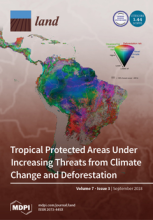Land Library
Welcome to the Land Portal Library. Explore our vast collection of open-access resources (over 74,000) including reports, journal articles, research papers, peer-reviewed publications, legal documents, videos and much more.
/ library resources
Showing items 19 through 26 of 26.Sustainable rural development (with the development of social functions) is currently one of the basic objectives of the rural areas policy in Poland.
In many African countries and especially in the highlands of Ethiopia—the investigation site of this paper—agricultural land is highly fragmented. Small and scattered parcels impede a necessary increase in agricultural efficiency.
Mainland Southeast Asia (MSA) has seen sweeping upland land use changes in the past decades, with transition from primarily subsistence shifting cultivation to annual commodity cropping. This transition holds implications for local upland communities and ecosystems.
Recently, we witnessed an immense increase in international land transactions in the Global South, a phenomenon slowly expanding in northern industrialized countries, too.
This paper seeks to understand the drivers and pathways of local livelihood change and the prospects for transformation towards a more sustainable future.
Smallholder teak (Tectona grandis) plantations have been identified as a potentially valuable component of upland farming systems in northern Laos that can contribute to a “livelihood transition” from subsistence-oriented swidden agriculture to a more commercially-oriented farming system, thereby
Many amenity-rich regions are experiencing rapid land-use change through low-density residential development or exurbanization. Those same natural-resource amenities that attracted migration are often degraded by housing growth and associated development.
Inclusive businesses (IBs), embodying partnerships between commercial agribusinesses and smallholder farmers/low-income communities, are considered to contribute towards rural development and agricultural sector transformation.






